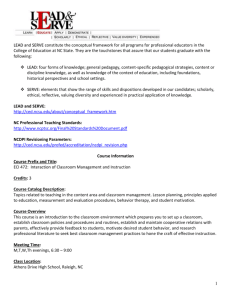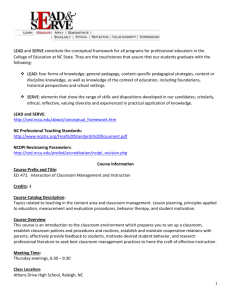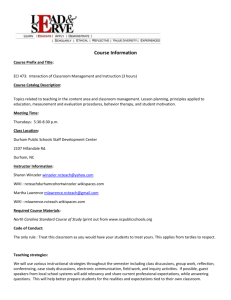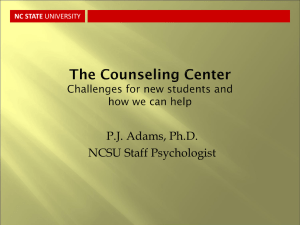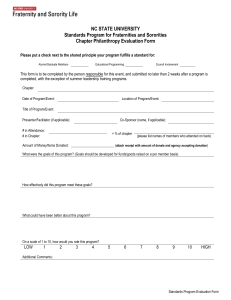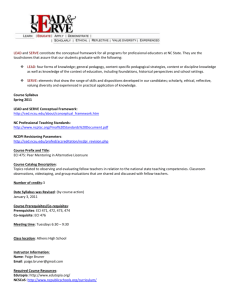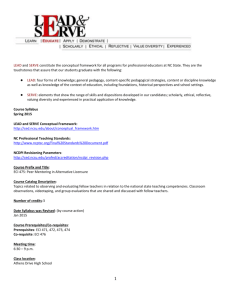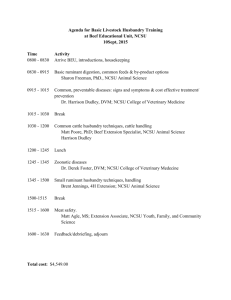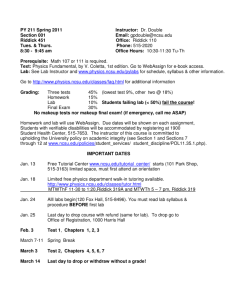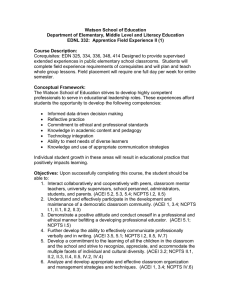Here is the class - ncteachbroer
advertisement
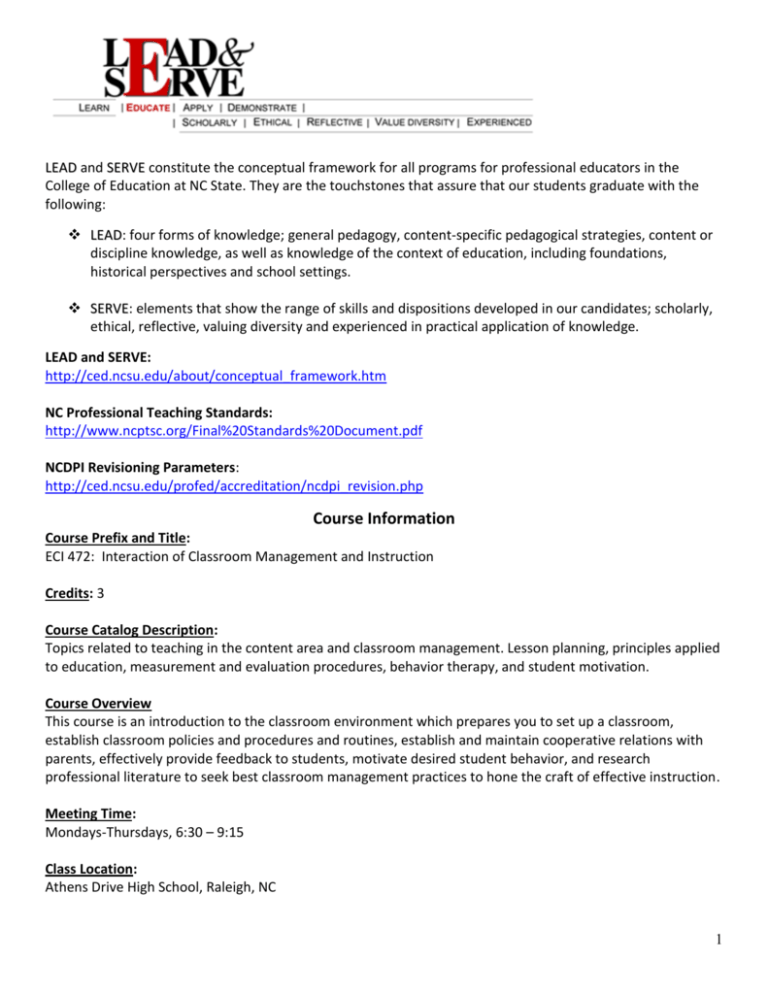
LEAD and SERVE constitute the conceptual framework for all programs for professional educators in the College of Education at NC State. They are the touchstones that assure that our students graduate with the following: LEAD: four forms of knowledge; general pedagogy, content-specific pedagogical strategies, content or discipline knowledge, as well as knowledge of the context of education, including foundations, historical perspectives and school settings. SERVE: elements that show the range of skills and dispositions developed in our candidates; scholarly, ethical, reflective, valuing diversity and experienced in practical application of knowledge. LEAD and SERVE: http://ced.ncsu.edu/about/conceptual_framework.htm NC Professional Teaching Standards: http://www.ncptsc.org/Final%20Standards%20Document.pdf NCDPI Revisioning Parameters: http://ced.ncsu.edu/profed/accreditation/ncdpi_revision.php Course Information Course Prefix and Title: ECI 472: Interaction of Classroom Management and Instruction Credits: 3 Course Catalog Description: Topics related to teaching in the content area and classroom management. Lesson planning, principles applied to education, measurement and evaluation procedures, behavior therapy, and student motivation. Course Overview This course is an introduction to the classroom environment which prepares you to set up a classroom, establish classroom policies and procedures and routines, establish and maintain cooperative relations with parents, effectively provide feedback to students, motivate desired student behavior, and research professional literature to seek best classroom management practices to hone the craft of effective instruction. Meeting Time: Mondays-Thursdays, 6:30 – 9:15 Class Location: Athens Drive High School, Raleigh, NC 1 Instructor Information: Eric Broer edbroer@ncsu.edu 919-818-2732 http://ncteachbroer.pbworks.com/w/page/58002668/FrontPage Required Resource: Science, Social Studies, or World Languages -- http://www.ncpublicschools.org/acre/standards/new-standards/ Math and English: Common Core (http://www.corestandards.org/) Resources (referenced, not required to be purchased) The First Days of School (video) (Harry Wong) Cooperative Discipline (Linda Albert) Course Objectives & Student Learning Objectives This course focuses on the fundamentals of classroom management and lesson planning for Lateral Entry teachers. By the end of this course, students will be able to: 1. Demonstrate knowledge of procedures for establishment of an effective classroom environment, including strategies and routines for fostering productive relationships with students and their parents. (LEADSERVE 1 & 4; NCPTS 1 & 2; CED Parameter 5 ) 2. Create appropriate classroom policies and procedures. (LEADSERVE 1, 4, & 6; NCPTS 1; CED Parameter 4 ) 3. Identify effective methods and techniques to motivate positive behaviors in all students. (LEADSERVE 8; NCPTS 2; CED Parameter 3 ) 4. Develop content specific lesson plans and assessment tools, (LEADSERVE 2 & 3; NCPTS 3 ; CED Parameter 1 & 2) 5. Reflect on teaching practice and focus on practical investigation and modeling of student-centered and activity-based methods designed to meet the individual needs of a diverse student population. (LEADSERVE 7 & 8 ; NCPTS 4 & 5; CED Parameter 3) Teaching Strategies: We will use various instructional strategies throughout the semester including class discussions, group work, reflection, conferencing, case study discussions, and electronic communication. Students will conduct demonstration lessons individually and will present in small groups. Overview of Course Requirements: Lesson Plans Demonstration Lessons (see rubric) In-class activities and class discussions Reflections (both verbal and written) Attendance (see attendance policy below) 2 Attendance: No more than 2 absences 2 tardies will count as an absence Your success in this course revolves around class discussions, individual and group activities, along with individual and group presentations; therefore, class attendance is mandatory. If an absence is unavoidable, please let the instructor know in advance. As a professional, you must make any decision about what obligations might keep you from attending class. Excessive absences (more than 2 excused or unexcused) will require you to repeat the course. Two tardies will count as 1 absence. For University policies on attendance, (excused and unexcused) absences, and scheduling makeup work please see: http://www.ncsu.edu/policies/academic_affairs/courses_undergrad/REG02.20.3.php Preparation & Participation: An NC TEACH is expected to be an active and informed participant in class proceedings. Active participation includes contributing to discussions on material presented and discussed in class. While doing so, you need to remain open and respectful to the ideas of others. If you disagree with someone or something, ground your opinion(s) to ideas/concepts/readings that have been referenced in course materials or in any of your previous courses. Students with Disabilities See: http://dso.dasa.ncsu.edu/ Reasonable accommodations will be made for students with verifiable disabilities. In order to take advantage of available accommodations, students must register with Disability Services for Students at 1900 Student Health Center, Campus Box 7509, 515-7653. For more information on NC State's policy on working with students with disabilities, please see: http://www.ncsu.edu/provost/hat/current/appendix/appen_k.html Inclement Weather Policy: North Carolina State University rarely closes for inclement weather. You need to make your own determination about your comfort level and safety if driving during inclement weather. Use your own good judgment when determining whether roads are safe to navigate. If class is not canceled and you cannot attend, you will be responsible for making up what you miss. The primary information resources for students, employees, and the public regarding the campus's current open/closed status are www.ncsu.edu (homepage) and 919-513-8888 (hotline). Major Assignments/Projects: Grade Distribution Lesson Plans (40%) – you will have a total of at least 3 – 90 minute lesson plans or 5 – 60 minute lesson plans that need to be written in lesson plan format (see Lesson Plan Format note below). Unit Plan/Pacing Guide (15%) Course Syllabus/Rules & Expectations (10%) Demonstration Lessons—two each person (20% total) – see rubric Reflections and other daily assignments (15%) –. Evaluation of Assignments: A - Above and beyond / over the top in terms of responsibility and commitment to excellence. Attends all classes and displays professionalism in both attitude and example. Explores issues from all directions and 3 models independent thinking in terms of application or utilization. Written work, where required, has no mechanical errors and is tied to facts and current educational philosophy. B - Goes a little beyond, while addressing all required criteria thoroughly. Attends class with few or no absences and consistently displays professionalism in both attitude and example. Explores issues and topics, but not in depth. Written work, where required, has few if any mechanical errors and is loosely tied to facts and current educational philosophy. C - Addresses all assignment criteria in an adequate way. Inconsistent with punctuality and class attendance. Demonstrates professional traits on occasion. Written work, where required, often lacks scholarship and needs extensive editing. D/F - Not acceptable and work will be returned for revision Letter Grade: NC TEACHers must earn a C or higher in each NC TEACH course to be recommended for licensure. A+ = 98 – 100 B+ = 87 – 89 C+ = 77 – 79 D+ = 67 – 69 F = Below 60 A = 95 – 97 B = 84 – 86 C = 74 – 76 D = 64 – 66 A- = 90 - 94 B- = 80 - 83 C- = 70 - 73 D- = 60 - 63 Academic Integrity The student code of conduct is available at: http://www.ncsu.edu/policies/student_services/student_discipline/POL11.35.1.php “8.3 The act of submitting work for evaluation or to meet a requirement is regarded as assurance that the work is the result of the student's own thought and study, produced without assistance, and stated in that student's own words, except as quotation marks, references, or footnotes acknowledge the use of other sources. Submission of work used previously must first be approved by the instructor.” Lesson Plan Format: All lesson plans should be part of the same unit and follow this format: 1. 2. 3. 4. 5. 6. 7. 8. 9. 10. Heading – subject, grade level, unit name, lesson name Objectives – written in terms of “students will” Common Core/Essential Standards – cite the number and the phrasing Focus/Review/Anticipatory Set – connect to prior knowledge and introduce the lesson and/or concept Input – sequence and description of all direct teaching; include notes and questions in "Handouts" section as well. Be sure to include all answers to activities, questions, and/or problems Guided Practice – sequence and description of all activities which reinforce direct instruction; include what students and teacher are doing along with answers to activities Closure – describes how the lesson will end and how the teacher will assess if the learning outcomes have been attained; should move beyond simply asking if there are any questions. Independent Practice – what homework will students complete that reinforces the concept? Handouts – include all handouts , teacher notes, and questions (both verbal and written) that would be used during class Reflection on Lesson – write a brief paragraph that evaluates the choices for the lesson, including its strengths and weakness See https://goo.gl/ak3G4N for the syllabus 4
